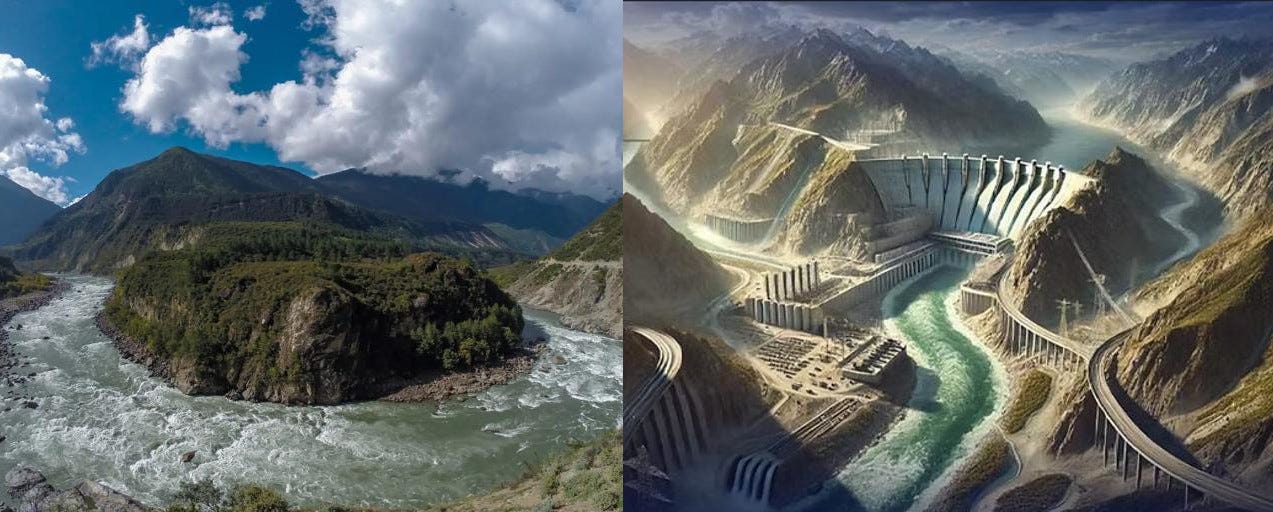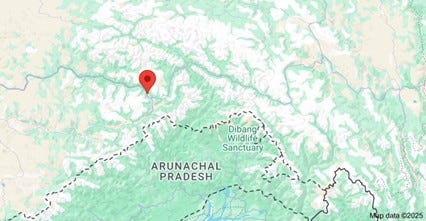China's Giant Tibetan Dam Evokes Concern
Environmental issues, water sovereignty, downstream impact don’t concern Chinese leaders
By: Nava Thakuria
China’s construction of what is expected to be the world’s largest hydropower dam on a spectacular, scenic horseshoe bend of the Tsangpo river in Tibet, which got underway on July 19, is attracting alarm for its environmental effect on the pristine Himalayan plateau as well as for its potential impact on millions of Indians and Bangladeshis living downstream, sparking international concerns over water sovereignty and complicating India-China relations that have lately begun a cautious thaw.
Tibetans both inside and outside the region have demonstrated against the Chinese dams on their sacred rivers, with thousands detained. Tibetan Buddhists remain concerned over serious threats to the fragile environment after disrupting the natural flow of rivers, impacting their culture and way of life and their traditional livelihoods. However, Beijing considers Tibet as an integral part of China and is continuing heavy resource exploitation. One fifth of Tibet is recognized as wildlife reserves, but those forests are hardly protected under the Communist administration.
Beijing has already generated concern by building several smaller dams on the Tsangpo, also known as the Yarlung Zangbo, before planning for this gigantic power station at Medog County, with a capacity of 60,000 MW. Government planners approved final plans last December to build five cascade hydropower stations costing 1.2 trillion yuan (US$167.8 billion) to generate nearly 300 million MWh of electricity annually, according to a report of the state-sponsored news agency Xinhua.
Often called the earth’s third pole, Tibet feeds some of the world’s most significant rivers including the Indus, Ganges, Brahmaputra, Irrawaddy, Salween, Yangtze, and Mekong, which flow through Pakistan, India, Bangladesh, Myanmar, Laos and Vietnam, supporting more than 1.5 billion people in South and Southeast Asia. Beijing’s continuing hydroelectric construction in the seismically active Tibetan plateau could put millions of people at risk who manage agriculture, fish farming, water transport, and daily consumption in the lower riparian countries.
The latest adventure on the Tsangpo’s dramatic loop around Namcha Barwa mountain in southeastern Tibet, hardly 30 km away from the Beijing-disputed Indian Arunachal Pradesh region, adds to strategic concerns for India’s federal government in New Delhi.
Originating from the western Tibetan glacier above 10,000 meters near Manasarovar Lake, the Tsangpo flows east, crossing mountainous terrain to enter Arunachal Province, taking the name Siang, then reaches Assam as the Brahmaputra, following which it enters Bangladesh and merges with the Padma to be named the Jamuna before culminating in the Bay of Bengal. It covers more than 2,850 km, of which 1650 km falls in Tibet, 916 km in India, and 337 km in Bangladesh.
New Delhi has been monitoring the Chinese interventions with growing alarm. Although the two have no functioning water sharing agreements, the central government has continually relayed its concerns to Beijing. A Foreign Ministry spokesperson recently stated that as a lower riparian country with established user rights, New Delhi insists on transparency and consultations, repeatedly urging Beijing to preserve the interests of the Brahmaputra’s downstream regions.
Bangladesh seemingly remains less concerned about the venture on the Brahmaputra. The current interim government in Dhaka recently indicated Beijing has assured there will be no water diversion under the project and that it shouldn’t affect water flows to downstream countries. An adviser recently commented that, according to Beijing, the new dam would be based on “multi-stage technology” designed to harness water flow without altering its volume. China earlier brought onstream the US$1.5 billion Zam (Zangmu) hydropower project generating 2.5 billion kWh of electricity annually on the same river a decade ago.
Beijing says the dam falls “fully within China's sovereignty” and aims to speed clean energy development while responding to climate change. The Chinese foreign ministry on July 23 argued that the project will help mitigate disasters along the entire Tsangpo. As the project was accepted after rigorous scientific evaluations, the ministry said, it won’t adversely affect the environment, geological stability, or water resource rights in the downstream regions.
Beijing says it’s sharing hydrological data, flood prevention and disaster reduction with lower riparian countries. President Xi Jinping described all these dams as a ‘win-win solution’ while reducing pollution and generating clean energy for economic growth for benefit to rural Tibetans. Visiting Medog county some years ago, Xi described the initiative as essential for Chinese clean energy goals.
The development has prompted New Delhi to step up work for a proposed 11,000-NW Upper Siang Multipurpose hydro-electric dam in Arunachal Pradesh which is expected to act as a shield against sudden water releases from the Chinese dam. The dam, with an estimated budget of US$13.2 billion, is projected as the most powerful hydroelectric project in India but has been facing opposition from local communities and environmental activists, claiming it would destroy the region’s fragile ecosystem and displace hundreds of thousands of indigenous families.
Arunachal government chief Pema Khandu, who supports the Siang hydropower project, termed the Medog dam a ticking water bomb for residents of his state, reiterating that China can hardly be trusted and Beijing might use the dam’s reserved water volume as a weapon against India, creating floods during rainy seasons and inducing droughts in winter days. Khandu charged that control over the river flow by a non-friendly neighboring government would put the livelihoods of thousands of downstream families in serious trouble although Assam chief minister Himanta Biswa Sarma argued that only 35 percent of its flow comes from the melting glaciers and limited rainfalls in Tibet, with much of its waters torrential monsoon rain-fed tributaries from Arunachal, Assam, Nagaland and Meghalaya along with Bhutan.
Prominent environmental activist Soumyadeep Datta, who leads a Save the Tsangpo-Siang-Brahmaputra campaign, pointed out that unless the land of the Dalai Lama gets independence from Beijing, the destruction of the fragile Tibetan plateau will continue. Expressing dismay over the continued exploitation of natural resources in Tibet by the ethnic Han, Datta urged the international community to support the ongoing Tibetan freedom movement.
Leaving aside the memories of the Doklam standoff in 2017, the Galvan valley clash in 2020, both of which cost Indian lives, and Beijing’s inherent support of Pakistan during a May 2025 clash, as Asia Sentinel reported on July 28, New Delhi has proposed various confidence-building measures with China. Two months ago, India’s Defense Minister Rajnath Singh visited China, whose foreign minister Wang Yi is expected to visit India soon. Prime Minister Narendra Modi may attend an important summit there.
Very recently, India’s foreign minister S Jaishankar arrived in Beijing for the Shanghai Cooperation Organization meet. The foreign ministers’ summit on 14 July also provided space for Jaishankar to hold discussions with Chinese Vice President Han Zheng to seek to build trust against the backdrop of border conflicts. However, within a few days, the Chinese authorities declared the beginning of work for the Medog power station.


